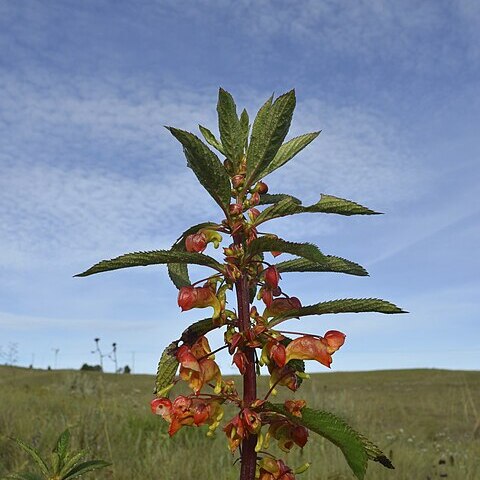Leaves spirally arranged, very rarely pseudopposite, petiolate; lamina 3–10 (14) × 1–2·5 (4) cm., lanceolate-elliptic, ovate-lanceolate or very rarely obovate-lanceolate, usually dark green on the upper surface, greyish-green on the lower one, glabrous above, shortly pilose or rarely glabrous beneath, apex acute, often acuminate, margin serrate-denticulate, base cuneate; secondary nerves 6–10 pairs, ± prominent beneath; petiole 0·5–3 (4) cm. long, rather slender, usually glabrous, with stipular glands at the very base.
Lateral sepals 4–7 × 1–2 (2·5) mm., ± asymmetrically lanceolate, triangular-lanceolate to ovate-lanceolate, usually glabrous; posterior sepal 7–9 mm. in diam. at the mouth, 1·5–2 (2·4) cm. deep, bucciniform, gradually tapering into the spur; spur up to 8 mm. long, sharply recurved (see t. 26 fig. 1), medium thick, ± cylindric, the end somewhat thickened, entire or very rarely inconspicuously bifid.
Flowers 2–6 in axillary fascicles, very rarely solitary, green-yellow tipped orange-red, scarlet shaded yellow, or orange; peduncle very short, not exceeding 4 mm.; bracts up to 4 mm. long, lanceolate-triangular, pilose or glabrous; pedicels 1·5–2·5 (4) cm. long, rather slender, glabrous or sometimes pubescent.
Anterior petal 7–12 mm. long, helmet-shaped, dorsally distinctly and broadly cristate; lateral united petals (7) 8–10 (12) mm. long, distinctly 2-lobed; anterior lobe c. 4·5–2·5 mm., obliquely elliptic to obovate-oblong; posterior lobe c. 7 × 4 mm., obliquely and broadly ovate.
Annual (always?) herb, up to 1·2 m. high; stems simple or moderately branched, erect or semi-prostrate, succulent, glabrous or sometimes somewhat pubescent mainly on younger parts.
Seeds numerous, c. 2 mm. in diam., subglobose, glabrous, rugose (see t. 26 fig. 29).
Capsule 1·5–2 cm. long, fusiform, usually glabrous.
Ovary glabrous.

